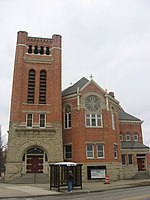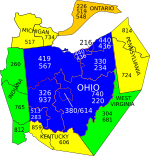Mercy Health - St. Vincent Medical Center

Mercy Health - St. Vincent Medical Center was the first hospital in Toledo, Ohio and is part of Mercy Health Partners. Mercy St. Vincent Medical Center (MSVMC), established in 1855, is the critical-care regional referral and teaching center within the Mercy Health Partners system. It is one among a seven hospitals system serving Northwest Ohio and Southeast Michigan. St. Vincent holds designations for treating high-risk mothers and babies, is a Level I Trauma Center for children & adults, and is an accredited Chest Pain Center.Through a partnership with University of Toledo Medical Center and St. Rita's Medical Center, the hospital operates both helicopter air-ambulances and ground-based critical care ambulances.
Excerpt from the Wikipedia article Mercy Health - St. Vincent Medical Center (License: CC BY-SA 3.0, Authors, Images).Mercy Health - St. Vincent Medical Center
Cherry Street, Toledo
Geographical coordinates (GPS) Address Website External links Nearby Places Show on map
Geographical coordinates (GPS)
| Latitude | Longitude |
|---|---|
| N 41.6683333 ° | E -83.5427778 ° |
Address
Mercy Saint Vincent Medical Center
Cherry Street 2213
43608 Toledo
Ohio, United States
Open on Google Maps








